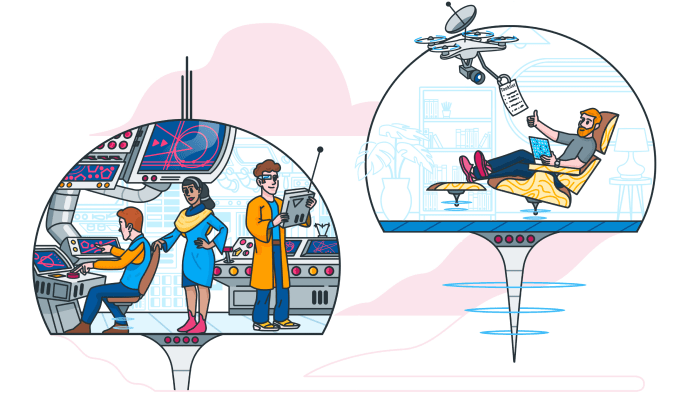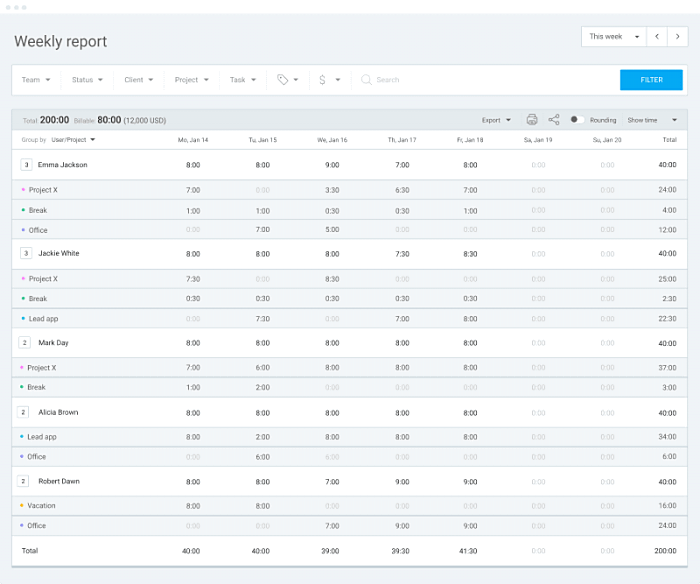Differences between managing in-house and remote employees
Last updated on: June 9, 2022
One of the major advantages of working on-site is spending time with your coworkers, getting to know each other, and learning more about their work habits. For team leaders, this setting allows them to manage their employees with ease. However, this won’t be the case when leading a remote team.
When faced with particular changes in the work setting, leaders would have to modify the way they work. For example, when managers need to switch to leading a remote, instead of an office team. According to a recent survey by the training company VitalSmarts, 20% of leaders are unprepared or very unprepared to lead their teleworking team.
These two work settings usually include a diverse set of rules. In this article, we’ll dive deeper into this topic by clarifying:
- the difference between an in-house and a remote model,
- the difference between managing in-house and remote employees, and
- tips for effectively managing a remote team.

Table of Contents
The difference between an in-house and a remote model
Before we start exploring the differences between managing in-house and remote teams, let’s first define these two categories of working environments.
An in-house team model
An in-house model is a model where employees are responsible only for the activities and projects of the organization they work in. In this case, workers align their work with the company’s goals and values.
The benefits of hiring in-house employees are:
- Intellectual property is secure.
In every company, there are some sensitive data about business operations, clients, etc. If these pieces of information get released, that would affect the company’s reputation. But, these risky situations are less likely to happen when business owners employ in-house workers.
- Consistent communication within the organization.
Being able to communicate with each other face-to-face can strengthen the relationship between employees and managers. Besides, sharing the same working environment can make the training process much easier whenever there are new employees.
- Better liability.
When deciding whether to hire in-house or remote employees, many business owners opt for office teams, because an in-house model oftentimes ensures a greater level of employee responsibility.
On the other hand, there are some drawbacks of an in-house model as well:
- Having overhead costs.
If they choose to hire an in-house team, employers will have to pay additional mandatory expenses. When making employee cost estimates, employers will have to include overhead expenses, too. Overhead costs consist of payments such as building costs and equipment.
- Hiring takes more time and effort than hiring remote employees.
Since in-house workers are hired on a long-term basis, employers will strive to find the most suitable candidates. Therefore, this process will sometimes take more time. So, hiring an in-house team would not be an option for any urgent projects.
- Finding proper candidates is limited.
When employing remote workers, business owners can consider candidates from all over the world, as long as they meet predetermined criteria. But, when it comes to an in-house team, employers would have to find someone from the same city or the same country.
A remote team model
Aside from employing an in-house team, employers can choose to hire remote workers. A remote team model is a type of outsourcing. In this case, businesses opt for recruiting remote employees to create a remote or distributed team.
The major advantages of having a remote team are:
- Hiring worldwide talents.
Since remote employees work from distance, employers can choose the most fitting candidates from around the world.
- Employing people at the right price.
To have lower resource cost benefits, businesses can hire resources from Tier 2 and Tier 3 countries. While the wealthiest countries belong to the Tier 1 category, Tier 2 are countries with a lower average income per person. As for the Tier 3 category, these are developing countries with low purchasing power.
- Fewer expenses per employee.
When having a remote team, employers are not obliged to cover health insurance, travel expenses and other costs. Thus, there will be fewer costs per worker. Plus, since employees are telecommuting, an office won’t be required, so there will be no overhead costs.
However, there are some disadvantages of hiring a remote team:
- A lack of face-to-face communication.
Remote workers have no choice but to communicate with each other via email, chats, and video conferencing. Without in-person communication, many people might feel isolated from their coworkers. And isolation is one of the most common challenges that remote workers experience.
In addition, employers and managers have to lead the team the same way, which requires more time and effort. Although the experienced team won’t have any communication issues, having a face-to-face approach is essential during the training process.
- Timezone management
If employees come from diverse corners of the world, time difference can be a major obstacle. Gathering team members for a daily or a weekly call would always be a tough task for a manager.
- Potential project failure
Hiring remote employees for a particular project can be an uncertain mission. Even when remote workers have a high level of experience and expertise, there’s a chance they won’t deliver work on time. Therefore, these delays can impact the project’s success.
To sum up, each model comes with its perks and downsides. Deciding what model to select for your company depends mostly on your company’s needs and goals.
The difference between managing in-house and remote employees
“Remote working is the future, but you need physical presence at least a couple of times a year to truly create an amazing team.” – Ricardo Fernandez
Ricardo Fernandez, one of the speakers at the TEDxIESEBarcelona, has been teleworking for more than 10 years with several companies. In the speech he presented for Tedx Talks, Ricardo pointed out that you can establish some sort of relationship with your team via video conferencing and emails. But, he claims that physical presence is necessary “to add empathy to your team.”
If you’ve ever wondered what leading a remote team looks like, we bet that physical distance was one of the main obstacles that have come to your mind. After all, when there’s no physical proximity, it’s even difficult to achieve teamwork in the workplace.
Now, if we compare managing in-house teams with remote ones, we’ll notice three critical challenges related to the latter:
- Time,
- space, and
- culture.
Time difference
We already mentioned that, within a telecommuting team, there are usually people from diverse time zones. As a manager of such a team, you need to schedule team meetings and other calls during periods that work for every team member. This is known as “time fairness”. And as you can imagine, this won’t be an easy task.
Apart from team meetings, you’ll need to think about time differences when setting deadlines. Your colleague living in Singapore should have an equal number of days to finish his task as his teammate from Seattle.
On the other hand, you probably won’t have these issues when leading an in-house team. No matter if your working hours are fixed or flexible, you and your team will spend at least a couple of hours per day together in the office. Thus, as their leader, you’re able to communicate with them in person and manage their assignments and deadlines with ease.
Space difference
Another challenge of working remotely is the physical distance between team members. When leading a remote team, the space difference affects mostly:
- Communication within the team.
The perk of working in an in-house team is that you reach out to your colleagues whenever you need help or advice. If you’re a manager, you can gather the team immediately whenever there are any urgent issues or latest updates on the project.
Then again, this won’t be the case with remote employees. Since they’re not sitting next to each other, teammates can’t communicate in person. So, they stay in touch via online communication tools.
Moreover, there are no face-to-face meetings like with an in-house team. So, as a remote leader, you have to arrange frequent video calls with the entire team. But, try not to schedule too many meetings. According to the recent Harvard Business School report, starting April this year there’s a 13% increase of meetings per person, compared to the first quarter of this year
(before there were worldwide lockdowns due to COVID-19 pandemic). Luckily, there’s a decline in the average length of these meetings – by 20%. This survey gathered 3.1 million workers from North America, Europe, and the Middle East.
To promote better communication and collaboration within the team, you should try using the team management software. For example, Twist is a communication app for remote teams, while Asana will help you manage tasks.
- The process of tracking employing performance.
Analyzing employee performance is convenient when leading an in-house team. Since you’re in the same work setting as your team, you have an overview of their work habits and ethics. However, in the case of a distributed team, monitoring their work can be tricky.
So, how to deal with this issue? One of the most practical solutions is an office team timesheet. Filling the timesheet is quite simple. Your team needs to enter hours worked on particular projects during the week. Then, in the Team Dashboard, you can see a visual breakdown of their week. Plus, there is a Weekly report, where you can glimpse who logged how many hours each day.

💡The process of tracking time with a team starts with setting a workspace. Learn more about other necessary steps that you and your team need to take.
Cultural difference
Speaking of cultural differences, remote managers need to aim their attention on:
- language barriers and how to break them down,
- understanding messages properly,
- identifying with cultural frameworks and contexts of other colleagues, and
- how to find a common ground among diverse cultural backgrounds.
By organizing frequent cross-cultural training programs for the entire team, you’ll get more familiar with varied cultures. Therefore, your remote employees will feel more comfortable, too. But, if you’re a leader of an in-house team whose members come from multiple cultures, be sure to also set up these educational sessions.
Now, here’s an interesting fact – different cultures can have different understandings of time. For instance, in South Africa, there are two commonly used expressions:
- “Now-now” – it will happen shortly, and
- “just now” – it will occur in the near future (in the next few hours).
So, keep this in mind if you have a coworker from South Africa.

Since there are many peculiar cultural norms throughout the world, you should provide your employees with some interesting publications on this topic. For example, you can start with The Culture Map, a book by Erin Meyer. This piece emphasizes the cultural differences and how they impact international business.
Expert tips on how to effectively manage a remote team
We’ve reached out to several experts in the field of management and organizational development, to learn more about their favorite strategies for managing distributed teams. These are their suggestions for anyone leading a remote team.
Make your remote team members feel connected and committed
Dr. Cristina Gibson is the Dean’s Distinguished Professor of Management at the Pepperdine Graziadio Business School, in Malibu, California. In addition, she is a co-author of the book Virtual Teams That Work: Creating Conditions for Virtual Team Effectiveness.
She believes that there are several basic ingredients necessary both for in-house and remote teams. These are:
- clear objectives;
- roles and responsibilities;
- regular feedback; and
- open and inclusive climate.
But, Dr. Gibson adds that in remote teams, there is a heightened need to ensure that members feel connected and committed.
“Working remotely can result in feelings of isolation and also distraction, given the settings in which we often work when not in-house. Therefore, making extra effort that meetings and check-in are engaging, supportive, and involve social and personal interaction, as well as task-focused activity is important.”
Stay away from the ‘one size fits all’ approach
According to Dr. Gibson, a mistake that managers often make is applying a ‘one size fits all’ approach to remote workers.
“Each team member quite likely has a unique situation in their remote location, and so the savvy manager will take time to understand the needs and priorities of each member, in order to better know how to support them in the way that will best be conducive to their contributions to the team.”
She explains that for some employees, this may mean maximizing flexibility in terms of work hours. But, for others, it might mean more regular and routine meetings, while some workers might need particular technologies.
“In an in-house team, these unique needs might be more obvious or intuitive, but understanding what each employee needs to be productive might require a more concerted discovery process on the part of the manager.”
Connect with your remote workers on a personal level
Joe Hopkins holds a Ph.D.in leadership and organizational development with a research focus on remote work. He has spent the last four years researching and writing on leadership in virtual work environments.
Hopkins claims that there are many similarities between leading traditional in-house team members and those working remotely. However, the most significant difference is intentionality.
“With in-house workers, many of the relationships form organically through impromptu “water-fountain” and coffee break conversations. Leaders of remote workers require a higher level of interdependent communication skills that need intentionality. The leader must be intentional in understanding the personality traits and needs of each individual and what inspires or drains them.”
Much like Dr. Gibson, Hopkins points out that one size does not fit all. Plus, he adds that structured team meetings are essential, but opportunities to connect on a personal level are equally needed.
“The introverted worker, who makes up 40% of the population, will not find a virtual team coffee break or team-building exercise energizing. Workers with higher levels of introversion require small groups or one-on-one conversations.”
So, according to Dr. Gibson and Joe Hopkins, managers leading remote teams need to communicate often with the team. This way, leaders will get to know their workers better. Furthermore, managers will understand individual needs and priorities of each team member.
Wrapping up
Leading a team whose members come from all over the world and from diverse cultural backgrounds might be a challenging task. Unlike with a traditional in-house setting, communication and collaboration with a distributed team have to be via online channels. Also, tracking employee progress needs to be done differently than when leading an in-house team.
So, how should you manage remote employees successfully? First of all, experts suggest that you shouldn’t have a “one size fits all” approach for your remote team. Instead, get familiar with your workers, their needs and priorities, so that they feel connected to the team.
In addition to this tip, you need to connect with your team members on a personal level. For instance, you can organize online team buildings or coffee breaks for the entire team. But, be sure that not all employees would feel comfortable attending a virtual gathering. For some of them, one-on-one calls might be a better idea.




